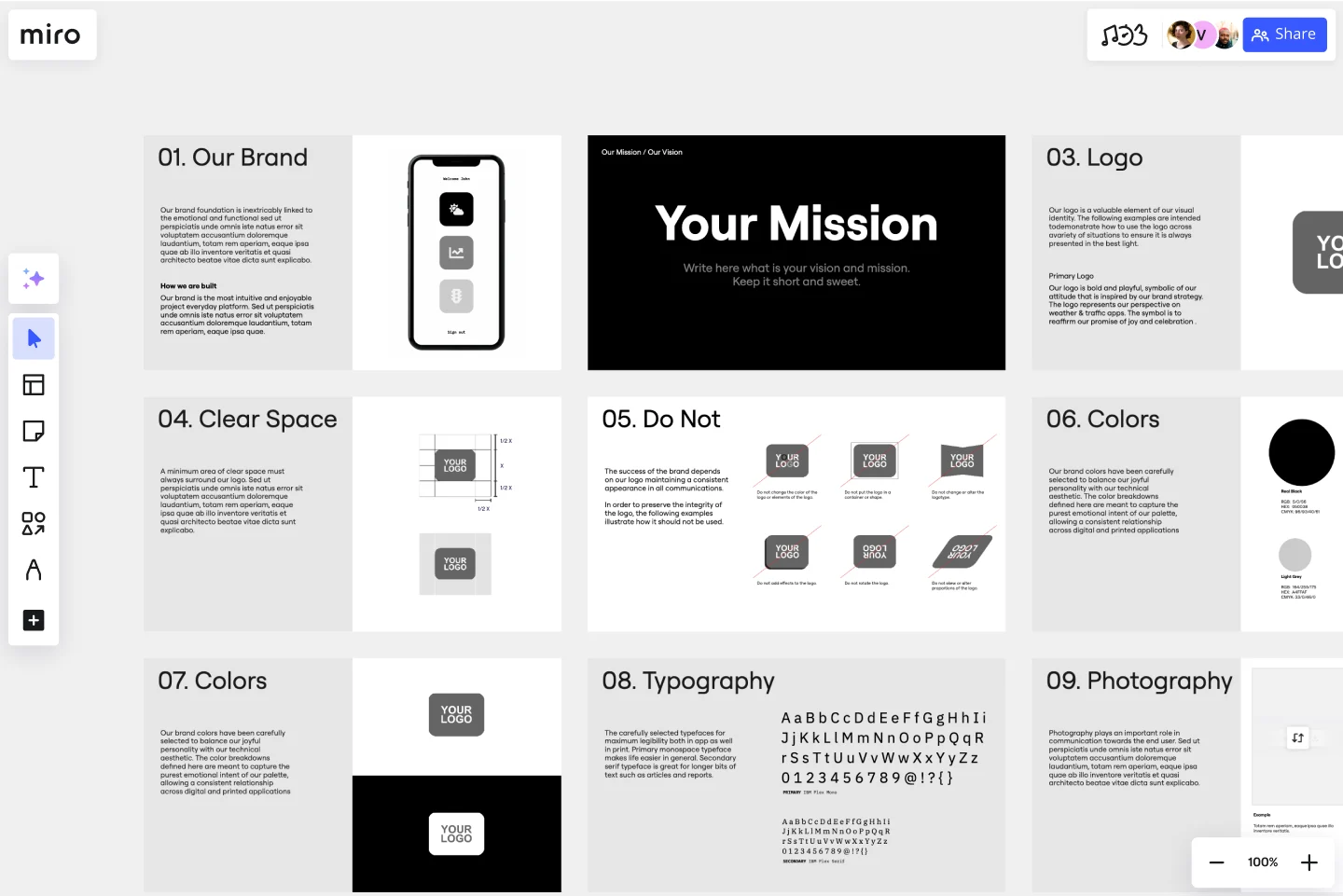Brand Guidelines Template
Identify and communicate your brand’s unique visual style and personality.
About the Brand Guidelines Template
When you think of your favorite companies, what do they have in common? For most of us, our favorite companies are defined by winning brands. The best brands are unique and instantly recognizable. They have a clear voice that informs the look and feel of their website, products, and services, marketing copy, and even how problems are solved. But brands don’t appear out of thin air.
Every great brand starts with documenting its unique brand guidelines to ensure consistency across the entire organization. These guidelines help flesh out the components that give your business its unique character. Brand guidelines should be flexible so your designers can have room to play but rigid enough to make your brand easily recognizable. That's where Miro's brand guidelines template comes in handy.
When to use the brand guidelines template
There’s never a wrong time to figure out your brand guidelines. For new businesses, brand guidelines are crucial to ensure consistency, establish trust, and foster brand recognition.
But not only new businesses can benefit from established brand guidelines. Treat them like a living document, and revisit your brand guidelines any time your brand needs refreshing: when you’re pushing into a new market, rebranding the organization, growing your business, or pivoting your product offerings.
Create your own brand guidelines
Making your own brand guidelines is easy using our simple template. Get started by selecting the brand guidelines template, then take the following steps to make one of your own.
Articulate your brand story and positioning statements. Your brand story is the narrative stream that runs through all of your marketing materials. It helps your customers connect with your brand by taking them through a journey: how you got here, what problem your brand is solving, what motivates you, and what you hope to achieve.
Connect with your customers. Customers respond to brands on an emotional level. What emotions do you want your customers to feel when they interact with your brand? Does your brand inspire loyalty? Creativity? Excitement?
Study your competitors. What do their brands look like? Dig into their voice and tone; how they present their brand; and what their products, services, websites, and marketing materials look like. Your goal here isn’t to copy competitors but to keep in mind that potential customers will be consistently comparing you to similar businesses and seeing how you measure up.
Define your brand personality. Think of your brand as a person. What are they like? How would you describe them to your friends? This brand personality will permeate everything you create. Once you nail it down, you can choose colors, fonts, photos, or other visual elements that align with your personality. Miro makes it easy to collaborate on your brand’s visual characteristics. Share graphics, talk through ideas, and iterate as a team.
Get started with this template right now.
Ansoff Matrix Template
Works best for:
Leadership, Operations, Strategic Planning
Keep growing. Keep scaling. Keep finding those new opportunities in new markets—and creative new ways to reach customers there. Sound like your approach? Then this template might be a great fit. An Ansoff Matrix (aka, a product or market expansion grid) is broken into four potential growth strategies: Market Penetration, Market Development, Product Development, and Diversification. When you go through each section with your team, you’ll get a clear view of your options going forward and the potential risks and rewards of each.
Lean Canvas Template
Works best for:
Agile Methodology, Strategic Planning, Agile Workflows
Business opportunities can get dense, cumbersome, and complex, and evaluating them can be a real challenge. Let a lean canvas streamline things and break down your business idea for you and your team. A great tool or entrepreneurs and emerging businesses, this one-page business model gives you an easy, high-level view of your idea — so you can stay focused on overall strategy, identify potential threats and opportunities, and brainstorm the various factors at play in determining your potential profitability in an industry.
Crowd Sourced Cause and Effect
Works best for:
Fishbone Diagram, Problem solving
The Crowd Sourced Cause and Effect template leverages collective intelligence to identify root causes of problems. By involving multiple team members, you can gather diverse perspectives and uncover insights that might be overlooked. This collaborative approach ensures a comprehensive analysis and fosters team engagement.
Presentation Template
Works best for:
Presentations, Education
At some point during your career, you’ll probably have to give a presentation. Presentations typically involve speaking alongside an accompanying slide deck that contains visuals, texts, and graphics to illustrate your topic. Take the stress out of presentation planning by using this presentation template to easily create effective, visually appealing slides. The presentation template can take the pressure off by helping your audience stay focused and engaged. Using simple tools, customize a slide deck, share slides with your team, get feedback, and collaborate.
Gantt Chart for Project Scheduling
Works best for:
Planning, Strategy
Gantt Chart for Project Scheduling helps you plan and visualize project timelines. It enables you to manage tasks, deadlines, and dependencies, ensuring efficient project execution. Ideal for project managers looking to streamline their scheduling process.
Target Audience Template
Works best for:
Marketing, Desk Research, Prioritization
Understanding your target audience is vital to business success. How can you market yourself effectively if you don’t know who you’re targeting? Using the Target Audience template, you can review valuable data about who your customers are and what they want from your product or service.
